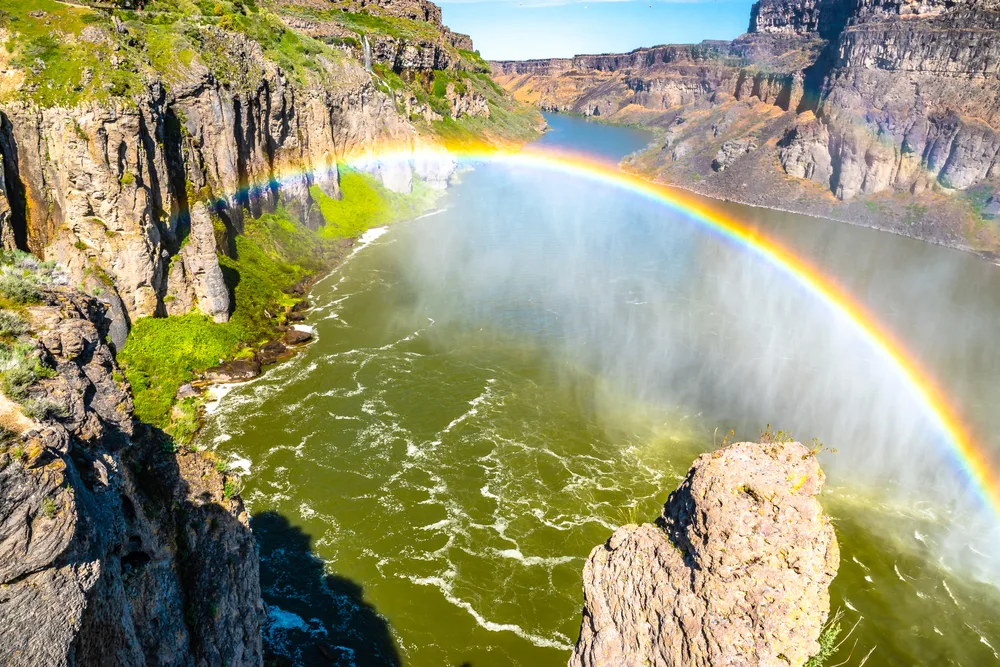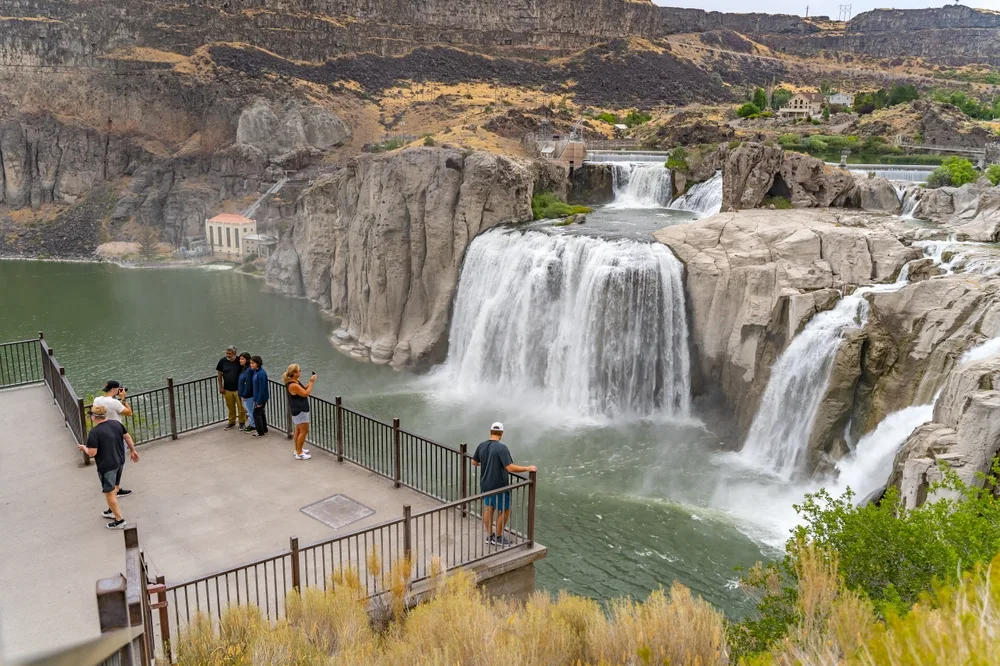What's the best time to visit Shoshone Falls?
The best time to visit Shoshone Falls is in spring, from April to June, when the snowmelt results in a smoother water flow over the falls. This season offers pleasant temperatures and the opportunity to enjoy waterfall viewing, picnics, hiking, and the visually captivating Shoshone Falls After Dark Event, featuring illuminated waterfalls. Additionally, May marks the opening of the Shoshone Ice Caves for visitors to explore.
Often called the “Niagara of the West,” Shoshone Falls is a must-see things to do in Idaho. Be it the mesmerizing waters, stunning rock formations, or dripping streams and frozen canyon walls, Shoshone Falls is beautiful every time of the year.
Yet, when’s the best time to visit Shoshone Falls according to your travel preferences? Follow our guide to see which period of the year works for you.
The Overall Best Time to Visit Shoshone Falls

Jeremy Janus/Shutterstock
The best time to visit Shoshone Falls is in spring, during the April–June period. The snow begins melting, making the water flow much smoother.
The period’s ideal for waterfall enthusiasts hoping to see the water making its way over the falls. And while many think they can do so in other periods of the year, the reality is different, as in other months, the fall can get quite dry.
In April, expect to see temperatures between a maximum of 58°F and a minimum of 38°F. May has temperatures ranging between average highs of 68°F and average lows of 45 °F.
June sees the highest average temperatures, fluctuating between a maximum of 80°F and a minimum of 54°F.
Going in spring means you can also enjoy a picnic lunch overlooking the falls without breaking a sweat. If you wish to have a more dynamic stay at the falls, hit the hiking trails with a fellow hiker and have fun in nature.
The highlight of the season, the Shoshone Falls After Dark Event, is a true visual treat, given the playful illumination of the waterfalls. Finally, May marks the opening of the Shoshone Ice Caves, so make sure to pay them a visit.
Cheapest Time to Visit Shoshone Falls
The cheapest time to visit Shoshone Falls is in late autumn and winter, from October to February, are ideal for those wanting to stick to a budget.
This period sees no vehicle admission fees, so this is a nice start to your Shoshone Falls visit. Also, these months are when you have the best chances to find affordable accommodation, as it’s off-season, and score cool airfare deals.
October and November see average temperatures between 63°F and a 31°F. December and February’s temperatures vary between an average high of 36°F and an average low of 23°F.
Weather-wise, hiking is awesome these months, and the days allow you to wander Shoshone Falls Park. You can even bring your pet along, but make sure they’re on a leash.
Winter may put off many travelers from visiting, but those who do make it to Shoshone Falls witness magnificent wintery works of art — frozen waterfall views unlike anything you’ve ever seen.
And if you feel like you’ve seen it all, wait till you come across information regarding the Festival of Lights Parade in Twin Falls. Finally, if you wish to add a bit of fun to your visit and you happen to visit in autumn, head to the Twin Falls Oktoberfest.
With live music performances, food corners, and activities such as hot wings eating competitions, your secluded Shoshone Falls trip in nature will transform into a highly engaging social activity.
Least Busy Time to Visit Shoshone Falls

Michael Gordon/Shutterstock
The least busy time to head to Shoshone Falls is in January. January has average temperatures of 37°F, going down to a minimum of 23°F. If you wish to have the waterfalls all to yourself, this is the month to go.
Winter idyll at the falls means frozen icicles, and January is their peak. That said, note that while Shoshone Falls is open during the entire year, some roads may close due to heavier snowfall.
If things get too quiet for you here in January, you can, again, head to Twin Falls for a round (or two) of ice skating.
Finally, if you wish to enjoy the falls without the busy crowds and people-packed viewing platforms, avoid weekends and afternoons. The best time to go is early in the day — that way, you can also more easily find a place in the parking lot.
Worst Time to Visit Shoshone Falls
Although a year-round attraction, the worst time to visit Shoshone Falls is during the July–September period. July, August, and September have average temperatures hovering around 92°F during the day and 54°F at night.
In the summer period, the water from Snake River is redirected to the farm fields in the surrounding area for irrigation purposes. This means the waterfall isn’t as stunning as it is in spring and might even be completely dry at times.
It all depends on prior rainfall. So, save yourself from a huge disappointment, and head to Shoshone Falls in the spring period. That said, just because the falls aren’t at their best, they’re still a stunning sight.
In fact, if you happen to visit Shoshone Falls when the falls are more or less bare, you can take a closer look at what lies beneath the water — the rock formations.
So, there may not be a huge waterfall, but the canyon and the geological insights that come with it are there to compensate — if that’s your thing.
Things to Consider

Marcsanchez/Shutterstock
Visiting a location you’ve never been to can be challenging, especially when you wish to make the most of your time there, which is why we believe getting the most relevant information can help tremendously.
With these things in mind, you’re bound to enjoy your Shoshone Falls getaway:
- While Shoshone Falls is the most significant attraction in the whole area, we suggest extending your trip to a few days to explore the surrounding environment. Connecting Jerome and Twin Falls, the Perrine Memorial Bridge should be part of your Idaho agenda. Being 1500-foot-long and having four lanes, this impressive bridge provides visitors with observation decks and parking areas on both sides so people can enjoy the stunning views.
- Be sun-ready with SPF cream and a hat, as there’s minimal shade in the area.
- Spring is the best time to visit, but if we had to pick one month, it’d be April — it has the most consistent water levels, and you might even catch a rainbow or two, together with some spectacular misting that will take your photography skills to the next level! This brings us to the next point.
- You’ll come across many rock chucks within the park area, and while feeding them is tempting, you’re discouraged from doing so.
- Bring binoculars to see the seemingly “unseeable” sandy aspects that the falls are made up of.
So, What’s the Best Time to Visit Shoshone Falls?

Twin Falls, ID, USA – August 5, 2022: Shoshone Falls or Niagara of the West, in Twin Falls, Idaho. Observation deck with tourists/Iv-olga/Shutterstock
The best time to visit Shoshone Falls is in spring, during the April–June period. Water flow is at its highest, the temperatures are pleasant, and recreational activities are in full swing.
The worst time to visit Shoshone Falls is during the July–September period. The water flow gets quite low (if we’re being honest, even non-existent at times), and the overall landscape comes nowhere near its spring appearance.
That said, this is the time when history buffs can get insights into the geological rock formations and observe the big canyon. All in all, if you want an ideal visit to the Shoshone Falls, head there in April, May, or June. You certainly won’t be disappointed!



